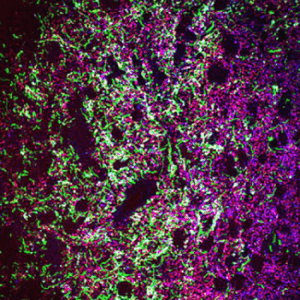The University of California San Diego’s School of Medicine has recently identified the part of the brain that controls disappointment among mammals. Researchers have been granted a new insight into why and how people feel disappointed. Seeing the glass half empty may no longer be a matter of perspective, but rather brain chemistry.
The researchers at UC San Diego experimented with rodents and discovered a region in the brain, above the thalamus (located in about the center of the brain), called the lateral habenula, or LHb. The LHb releases two types of opposing neurotransmitters, the excitatory glutamate and the inhibitory GABA (1). This discovery is unique because most neurons only produce one kind of transmitter. Only two other brain systems are able to release both excitatory and inhibitory transmitters: the hippocampus and the brainstem (2).

Green basal ganglia neurons release red glutamate and blue GABA in the brain resulting in the sporadic mix of both neurotransmitters, shown in white. Credit: UC San Diego’s School of Medicine
Further experimentation with monkeys unveiled that LHb activity increased as they were denied an expected treat, producing higher levels of GABA, leading to the conclusion that the LHb is linked to emotional disappointment Also in their experimentation, researchers observed that rodents that exhibited signs of human depression produced a lower level of GABA relative to glutamate. When given antidepressants, their relative GABA levels increased, furthering the relationship between the LHb and emotions related to disappointment (1).
Researchers found that hyperactivity of the LHb plays a role in depression. Previously, researchers had little direction regarding preventing hyperactivity in this region of the brain due to the lack of neurons in said region (1).
The LHb is believed to control much more than disappointment. It has also been suspected of regulating reactions to pain and a depth of motivational behaviors. It may even have a role to play in psychosis (2).
However, despite all these advances, researchers are still stumped as to why this region of the brain is controlled with both inhibitory and excitatory neurons. One suggestion is that by having the two neurotransmitters counteract each other there is a finer control of signaling.
Sources:
1. Scientists discover ‘dimmer switch’ for mood disorders. (2014, September 18). ScienceDaily. Retrieved September 25, 2014, from http://www.sciencedaily.com/
2. Shabel, S. J., Proulx, C. D., Piriz, J., & Malinow, R. (2014). GABA/glutamate co reelase controls habenula output and is modified by antidepressant treatment. Science, 345(6203), 1494-1498. Retrieved September 24, 2014, from http://www.sciencemag.org/content/345/6203/1494.short